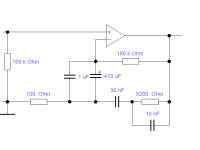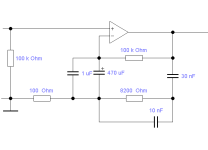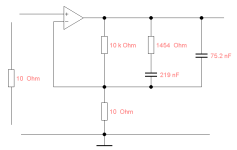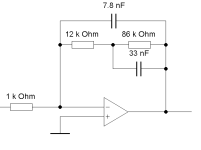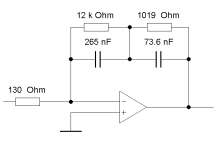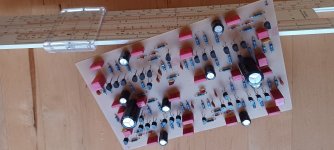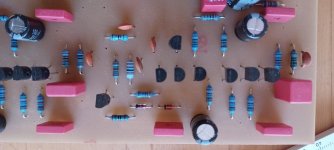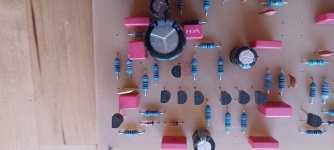Due to a rather small sized transistor we can go totally extreme and do one PSU for each channel - obviously in an extra external housing. 
I must admit a well documented summed up project - I wouldn't mind having one of those PCBs but can't provide one.
Let's see if someone jumps in and does a nice design.
I must admit a well documented summed up project - I wouldn't mind having one of those PCBs but can't provide one.
Let's see if someone jumps in and does a nice design.
Well you were quicker than I was able to comment 
Honestly, that's a well documented design with potential.
I would even go into the extreme and say let's do two of those cheap PSUs in an external housing - for each channel one!
Otherwise the housing would be very empty
I must admit the project went from a fun story into something more than real and as initially mentioned I do like the approach with BJTs - let's call it a well proven old school way.
If all the used components are nicely matched I don't see a reason why this project shouldn't be a good MM phono.
Unfortunately I cannot provide anything for this project than my comments but if there were any PCBs I would go for it.
I think it's worth to give it a shot - DIY as should be
Honestly, that's a well documented design with potential.
I would even go into the extreme and say let's do two of those cheap PSUs in an external housing - for each channel one!
Otherwise the housing would be very empty
I must admit the project went from a fun story into something more than real and as initially mentioned I do like the approach with BJTs - let's call it a well proven old school way.
If all the used components are nicely matched I don't see a reason why this project shouldn't be a good MM phono.
Unfortunately I cannot provide anything for this project than my comments but if there were any PCBs I would go for it.
I think it's worth to give it a shot - DIY as should be
Today
is my birthday and Haudegen gave me a book as a present, he had hidden it in his old leather bag: "the sound of silence, by Burkhard Vogel ISBN 978 3 540 76883 8".
Dear Chestnutspread,
if you would like to test the virtual battery concept, then I would perhaps also tend towards the double mono - also just so that the flat case doesn't look so empty.
But the most important thing is really the transformer; it must not interfere with the inevitable stray electromagnetic field.
You should also think about shielding e-fields, at least rudimentarily. And please no microcontroller (to do fancy things) in low noise preamplifiers.
Regarding jumping on the bandwagon, I don't think the Capri Fisher will do that, they are fully occupied with trading their nets back and forth. In the hope of finally hitting the big time ...
With regard to self-build, I agree with you wholeheartedly, you could also work completely discreetly, without any OPs.
If you know the EQ of the acoustic research A-03, give it a pair of reading glasses and plug in your MC, put on a good record - the world is also completely in order.
And so on.
HBt.

is my birthday and Haudegen gave me a book as a present, he had hidden it in his old leather bag: "the sound of silence, by Burkhard Vogel ISBN 978 3 540 76883 8".
Dear Chestnutspread,
if you would like to test the virtual battery concept, then I would perhaps also tend towards the double mono - also just so that the flat case doesn't look so empty.
But the most important thing is really the transformer; it must not interfere with the inevitable stray electromagnetic field.
You should also think about shielding e-fields, at least rudimentarily. And please no microcontroller (to do fancy things) in low noise preamplifiers.
Regarding jumping on the bandwagon, I don't think the Capri Fisher will do that, they are fully occupied with trading their nets back and forth. In the hope of finally hitting the big time ...
With regard to self-build, I agree with you wholeheartedly, you could also work completely discreetly, without any OPs.
If you know the EQ of the acoustic research A-03, give it a pair of reading glasses and plug in your MC, put on a good record - the world is also completely in order.
And so on.
HBt.
For me, DIY actually always means that I create my own layout.
Dear chestnutspread,
I'm afraid the time difference between Europe and the continent makes a discourse difficult ... have you noticed that our network is not a stupid one? The project can be activated immediately and you save yourself any gimmicks.
See for yourself.
But now the project loses any hint of specialness, so it still works perfectly.
Haudegen becomes active
You have to offer the youth group something special, with a daring touch. But how do you do that?
Do the ancient Greeks know the answer? I don't know. Every professional does it a little differently and every hobbyist even more so.
Who cares
Dear chestnutspread,
I'm afraid the time difference between Europe and the continent makes a discourse difficult ... have you noticed that our network is not a stupid one? The project can be activated immediately and you save yourself any gimmicks.
See for yourself.
But now the project loses any hint of specialness, so it still works perfectly.
Haudegen becomes active
You have to offer the youth group something special, with a daring touch. But how do you do that?
Do the ancient Greeks know the answer? I don't know. Every professional does it a little differently and every hobbyist even more so.
Who cares
Attachments
cheers and happy birthday!Today
is my birthday
Set up the transfer function if you have the time and inclination. One thing to bear in mind, of course, is that a non-inverting basic circuit cannot attenuate, i.e. at some point u2/u1 (as a function of frequency) will approach unity and this may well need to be taken into account ...
In Germany, a program called "Sprint Layout" has been very popular for some time and is very inexpensive. You also often see KiCad here on the board. So there shouldn't be any real hurdles to trying your hand at PCB design.
Haudegen will probably continue to use BoardMaker 1, 2 - with a DOS emulation. He never got version 3. He is now an old nostalgic, but he can still dive. Unfortunately, we could only make out cultured pearls, they all look the same.
Haudegen will probably continue to use BoardMaker 1, 2 - with a DOS emulation. He never got version 3. He is now an old nostalgic, but he can still dive. Unfortunately, we could only make out cultured pearls, they all look the same.
Dear Diary!
We have to leave as soon as possible, tragically Haudegen's landlady has died. They lived under one roof for twenty-eight years, almost like Mr. Holmes and Mrs. Hudson in the Baker Street of London. Tomorrow we must now pay our last respects to her. It is a great drama, an immeasurable loss, a shock.
Networks
The following ensemble may be better known. DIY is actually like a big LEGO construction set. We can also rearrange the passive voltage divider a bit.
We have to leave as soon as possible, tragically Haudegen's landlady has died. They lived under one roof for twenty-eight years, almost like Mr. Holmes and Mrs. Hudson in the Baker Street of London. Tomorrow we must now pay our last respects to her. It is a great drama, an immeasurable loss, a shock.
Networks
The following ensemble may be better known. DIY is actually like a big LEGO construction set. We can also rearrange the passive voltage divider a bit.
Attachments
Our LEGO bricks are becoming more colorful:
This network, a complex resistance, can be also activated.
Let's see
(two other networks are very well known and can also be found in ancient table books)
This network, a complex resistance, can be also activated.
Let's see
(two other networks are very well known and can also be found in ancient table books)
Attachments
My Diary
Yes, Haudegen is also a kind of detective with mild Asperger's syndrome. I hope his therapist will leave him in my care for a while longer and won't be so strict with us. She's so sweet.
Networks and two poles
Let's call the better known of the two dividers number 1 and the one I prefer number 2. Then there are two complex resistors missing, number 4 can be found in almost every commercial product. Number 3 is largely unknown. We juggle with these components, including the operational amplifiers.
Would anyone like to prepare a summary of the best-known implementation options and set out the dimensioning rules? Questions?
Yes, Haudegen is also a kind of detective with mild Asperger's syndrome. I hope his therapist will leave him in my care for a while longer and won't be so strict with us. She's so sweet.
Networks and two poles
Let's call the better known of the two dividers number 1 and the one I prefer number 2. Then there are two complex resistors missing, number 4 can be found in almost every commercial product. Number 3 is largely unknown. We juggle with these components, including the operational amplifiers.
Would anyone like to prepare a summary of the best-known implementation options and set out the dimensioning rules? Questions?
Attachments
From the evidence room
Network 3 in discrete single-ended circuit, a total of four discrete operational amplifiers.
Measured deviation at 30Hz -0.5dB and at 16kHz +0.3dB ... k is relatively large with less than or equal to 0.2%. Everything under full scale just before clipping. The preamplifier is mainly built with PNP and the actual equalizer with NPN transistors ... they are virtually a mirror of each other.
In normal operation, the k>0.001%, so everything should be totally normal.
You can clearly see the dust from this study.
MM
and MC suitable.
Network 3 in discrete single-ended circuit, a total of four discrete operational amplifiers.
Measured deviation at 30Hz -0.5dB and at 16kHz +0.3dB ... k is relatively large with less than or equal to 0.2%. Everything under full scale just before clipping. The preamplifier is mainly built with PNP and the actual equalizer with NPN transistors ... they are virtually a mirror of each other.
In normal operation, the k>0.001%, so everything should be totally normal.
You can clearly see the dust from this study.
MM
and MC suitable.
Attachments
Before deciding the type of RIAA network I like to suggest to get rid of the OPs.
There is a very well regulated PSU and not a wall wart amps - why not push this project any further.
The input stage could be done with a complementary differential amplifier with gain and RIAA in the feedback section.
For maximum stability a current source with an additional transistor, 1-2 resistors and diodes would be a nice feature.
To achieve a low noise input stage and build a magnifying glass for the MM we need transistors with a quick slew rate to avoid limitations.
My mayor issue is to find any that are not SMD types - my fingers can't handle those fiddly thingys.
Easiest can be the good old BC550C/560C types but there are better ones - hard to say...
There is a very well regulated PSU and not a wall wart amps - why not push this project any further.
The input stage could be done with a complementary differential amplifier with gain and RIAA in the feedback section.
For maximum stability a current source with an additional transistor, 1-2 resistors and diodes would be a nice feature.
To achieve a low noise input stage and build a magnifying glass for the MM we need transistors with a quick slew rate to avoid limitations.
My mayor issue is to find any that are not SMD types - my fingers can't handle those fiddly thingys.
Easiest can be the good old BC550C/560C types but there are better ones - hard to say...
The same used types can be used on the output stage and we can get rid of the OP and reduce the noise floor probably depending on the replaced OPs 
In the end it can be done with a complementary set of transistors and in buying a bulk we can reduce the pricetag and are free to match as much as necessary.
Sounds like fun on the workbench.
Need to install a Spice or whatever to bring the idea on paper an see if something explodes
In the end it can be done with a complementary set of transistors and in buying a bulk we can reduce the pricetag and are free to match as much as necessary.
Sounds like fun on the workbench.
Need to install a Spice or whatever to bring the idea on paper an see if something explodes
I guess you already mentioned the Elektor Supa - my suggestion is not that far of anymore.
With an entire discrete solution we are closer to the 80's which is in some kind of authentic due to talking about phono amps.
I find the idea more than charming to try something here that's not just mentioned in the datasheet of an LMxxxxx.
Hardest part is checking for availablity of good trannys - a time-consuming process!!
With an entire discrete solution we are closer to the 80's which is in some kind of authentic due to talking about phono amps.
I find the idea more than charming to try something here that's not just mentioned in the datasheet of an LMxxxxx.
Hardest part is checking for availablity of good trannys - a time-consuming process!!
The solution that immediately springs to mind is a reboot of the equalizers of the NAD 3020i and the AR A-03. Suitable low-noise bipolar transistors exist on the market and I'm sure I still have some in stock. But now we are moving far away from the original idea and becoming sensible and economical.
I like your approach. As a network, however, I would then consistently use number 4. There is still a lot to consider and learn here.
Regards,
HBt.
Psst.
Choose 2SC 2240 GR and 2SA 970 GR.
So now I would like to watch the further development of a "Haudegen project" and provide the snacks, a few bottles of beer - put it back and enjoy.

I like your approach. As a network, however, I would then consistently use number 4. There is still a lot to consider and learn here.
Regards,
HBt.
Psst.
Choose 2SC 2240 GR and 2SA 970 GR.
So now I would like to watch the further development of a "Haudegen project" and provide the snacks, a few bottles of beer - put it back and enjoy.

@Chestnutspread
Developing a suitable discrete amplifier as a first step is a great idea, an op-amp with five bipolar transistors, awesome.
So I'm in. As a network I would like the best known, see above - the number 4.
Back to current affairs
My friend Haudegen and I are sitting in the car, this time not in the clunker, I gave the Fiat500 to an old fisherman. More mass, smoother running - and my co-driver falls asleep straight away, he's having a good time. Okay, I'm the engine and he's the brain.
Take a look at what he just scribbled on the paper. I can tell you it's going to get me into a lot of trouble with his doctor. I have a bit of a crush on her. If he has a nervous breakdown now, it'll be my fault.
Bye,
HBt.
Developing a suitable discrete amplifier as a first step is a great idea, an op-amp with five bipolar transistors, awesome.
So I'm in. As a network I would like the best known, see above - the number 4.
Back to current affairs
My friend Haudegen and I are sitting in the car, this time not in the clunker, I gave the Fiat500 to an old fisherman. More mass, smoother running - and my co-driver falls asleep straight away, he's having a good time. Okay, I'm the engine and he's the brain.
Take a look at what he just scribbled on the paper. I can tell you it's going to get me into a lot of trouble with his doctor. I have a bit of a crush on her. If he has a nervous breakdown now, it'll be my fault.
Bye,
HBt.
Attachments
Two differential amplifiers and one unbalanced output. That should be the basis without a SUPRA clone seeing the light of day and without us copying from NAD or Acoustic Research. Install PSPICE and search for suitable models.
Gosh,
now I too find the project extremely exciting.
Many thanks "Kastanie"

HBt.
Psst
If we do everything right, then our EQ could well compete with Salas's Ultra and Wayne's Pearl three, only in MM mode of course.
Gosh,
now I too find the project extremely exciting.
Many thanks "Kastanie"

HBt.
Psst
If we do everything right, then our EQ could well compete with Salas's Ultra and Wayne's Pearl three, only in MM mode of course.
- Home
- Source & Line
- Analogue Source
- "Haudegen": MM-Phono-EQ
